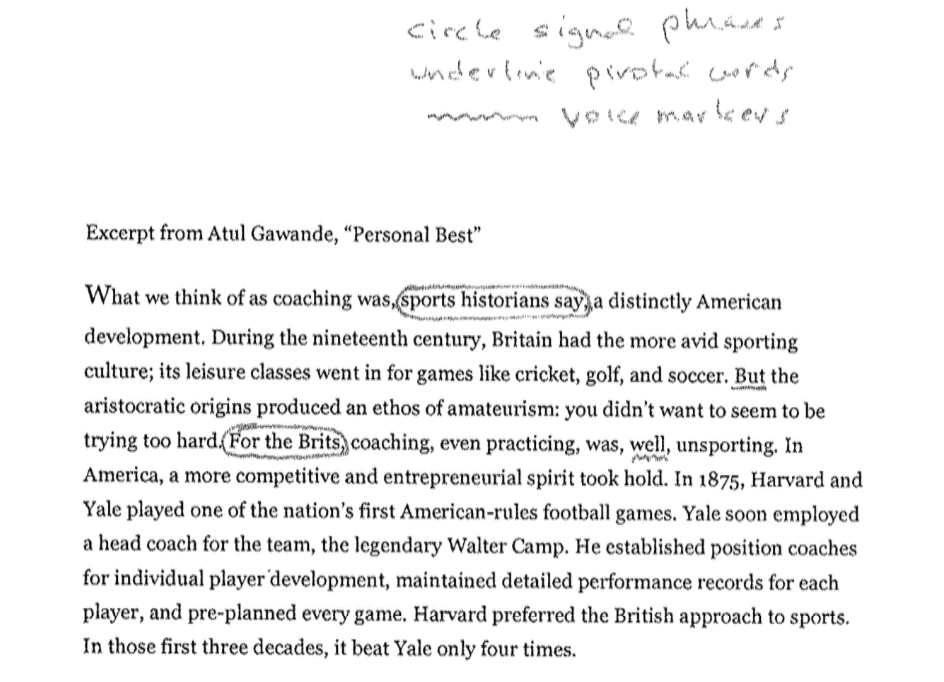PRO TIP: The second activity builds on skills practiced in the first one. So, do them in order.
Task 1 – Practice Seeing Signal Phrases, Pivot Words and Voice Markers – About 20 minutes
Learning Targets: seeing signal phrases, pivot words and voice markers, active reading, distinguishing what one writer says from what another writer says.
In They Say/I Say read “And Yet: Distinguishing What You Say from What They Say” to get a better handle on what voice markers are and how they work.
If you need a refresher on signal phrases, review “The Art of Summary” and “The Art of Quoting” chapters of TS/IS.
The pivotal words handout is here.
Test your ability to find and recognize these important reading signals in real world writing:
First, print this brief excerpt from Atul Gawande’s “Personal Best” (the New Yorker essay on which his “Get a Coach” Ted Talk was based).
Then circle every signal phrase, underline every pivotal word, and draw a squiggly line under every voice marker.
See the example paragraph just below.

When you’re done, take a photo of your work and post it as a new post called “Exercise 1” on your ePortfolio. Categorize your post as ENG 122 and Homework
Task 2 – Engage Atul Gawande – About 60 minutes
Learning Targets: writing fast, critical summary, integrate your ideas with those of other writers, signal phrase, pivotal words and voice markers
First, complete this pre-reading activity before going any further.
Next, print the transcript of surgeon Atul Gawande’s “Want to Get Great at Something? Get a Coach” and pull up his Ted Talk on your device.
While following along on the transcript, view and annotate Gawande’s Ted Talk. At the end of each page of the transcript, stop the video and make annotations on that page. See the yellow PRO TIP box below for what I mean by annotate.
Take photos of 2 pages of your annotations and post them on a new post called “Gawande annotations” on your ePortfolio. Be sure to categorize them with ENG 122 and Annotations
PRO TIP: Annotate: summarize the gist of paragraphs, look for concepts and keywords (and find the examples that go with them), make text-to-text and text-to-self connections, locate the problems or questions driving the text, write down questions you have and mark parts that you don’t understand.
Next, write a critical summary of what Gawande says about the “two views” of how professionals get better at what they do (Gawande 3:20). A critical summary will both convey Gawande’s ideas and evaluate them (pro tip: use voice markers and pivot words to express what you think about each of these views). A high school student should be able to understand your summary without reference to the original text, so you will need to frame quotations and paraphrased passages in your summary. Be sure to cite quotations and paraphrases by putting the start time of the quote or paraphrase in parentheses, like this: (2:32).
Target word count for this section of your homework: about 250 words
Finally, integrate your ideas with those of Gawande by shining a spotlight on relevant aspects of the two views he presents in order to answer the following question: How have your best teachers helped you get better at something you do? To make the shining a spotlight move, you will need to frame quotations and paraphrased passages.
The paragraphs you write in answer to this question should use keywords and concepts from Gawande’s Ted Talk to analyze and interpret your learning experiences with your best coaches.
Target word count for this section of your homework: about 250 words.
![SASC - Student Academic Success Center - UNE [logo]](https://s3.amazonaws.com/files.uneportfolio.org/wp-content/uploads/sites/5/2022/02/SASCLogoSquare_Smaller-3-e1644936452801.jpeg)